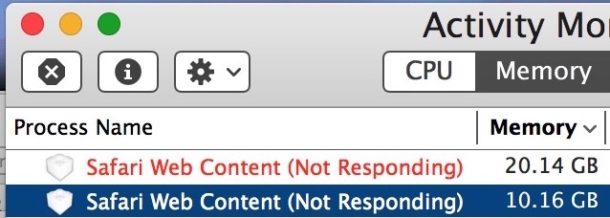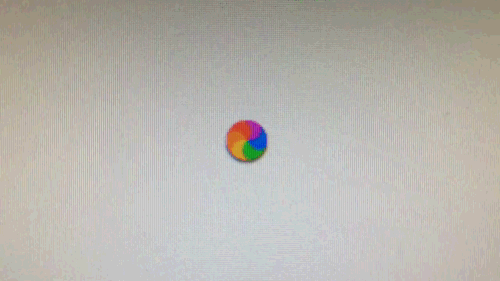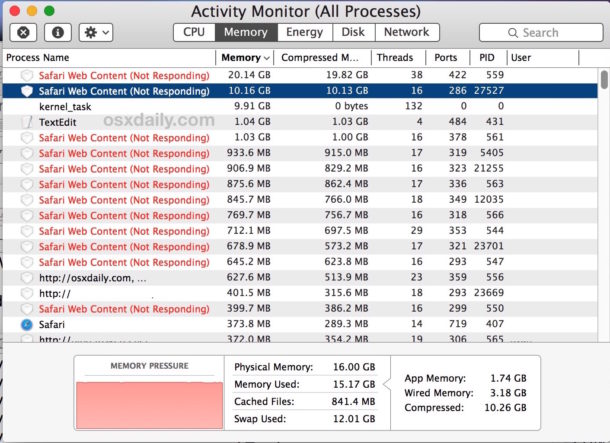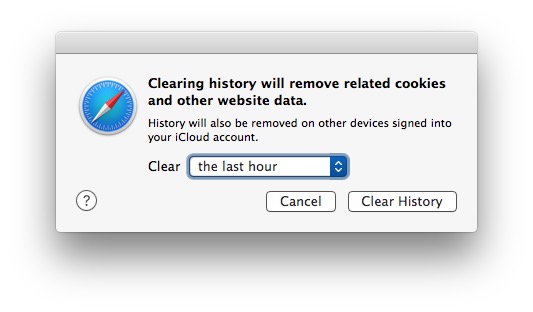Safari Web Content “Not Responding” on Mac? Fix the Beach Ball with These Tips

Mac Safari users may occasionally experience an issue where the web browser becomes unresponsive for an extended period of time, usually accompanied by the appearance of the spinning multi-color beach ball cursor. With a little digging under the hood, this almost always corresponds with the appearance of “Safari Web Process (Not Responding)” showing up in Activity Monitor in MacOS and Mac OS X.
The specific “Not Responding” Safari process situation is what we’re looking to resolve here with this troubleshooting guide. Users looking for a broader approach to Safari issues may want to refer to this guide to troubleshooting Safari freezes and crashes in Mac OS X including in Yosemite, El Capitan, and Sierra.

Easy First: Quit & Relaunch Safari
First things first, the simplest response to the Safari beach ball and stall-out is two parts; wait to see if the web page eventually loads, and if not, just quit out of Safari to re-open it and try again. This is the typical approach for most Mac users, and it often remedies the situation.
Easy Second: The Force Quit & Relaunch
If Safari is so unresponsive that it can’t be quit from the File menu, using Force Quit is a reasonable solution instead:
- Hit Command+Option+Escape to bring up the Force Quit menu
- Select “Safari” and then choose “Force Quit”
- Wait a minute or so as Safari is forced to exit and the system recovers, then relaunch Safari and go back to browsing as usual
![]()
As we said, that usually works just fine, and most Mac users are back to browsing the web in Safari again.
More Advanced: Targeting Specific Safari Web Content (Not Responding) Processes
More advanced Mac users can head over to the Activity Monitor application when the Safari beach ball makes an appearance, and typically in doing so you discover the bright red labeled “Safari Web Content (Not Responding)” process, if not several of them.
- Launch “Activity Monitor” found in /Applications/Utilities
- Under the CPU or Memory tab, find and located any red “Safari Web Content (Not Responding)” processes
- Click the (X) button in the toolbar to kill the selected process
- Repeat with other stuck red “Safari Web Content (Not Responding)” processes
- Exit out of Activity Monitor

Killing a “Safari Web Content (Not Responding)” process forces it to exit and then, usually, it automatically reloads in Safari. That alone can often fix the problem, but sometimes the beach ball returns immediately because the web process is loading errant javascript or a plug-in gone haywire, or is experiencing some memory leak or wild CPU spike.
In the attached screenshot, you’ll see nearly every Safari Web Content process is “Not Responding” and has gone haywire (except for osxdaily.com, woohoo!), eating up an absurd amount of real memory and virtual memory, dragging the kernel_task into the drain with it. As you can imagine in such a situation, Safari was completely unresponsive as was the rest of the Mac, and thus focusing on killing the entire “Safari” process was a faster solution than individually killing every individual process.
Fixing “Safari Web Content (Not Responding)” And Preventing Reoccurrences
Now that you know how to handle the errant Safari processes, what can you do to fix and prevent them from happening in the first place? There is no definitive answer for this because the root cause is not always determined, but there are many steps to take to limit the likelihood of Safari process going haywire with a beach ball and taking the Mac down with it.
Clear Caches and Browser History
Clearing web content caches and browser history often remedies a problem, but the downside is it will remove cookies and therefore any saved logins or other data from the Mac too, as well as anything else signed into the same iCloud account (kind of annoying, yes). So be prepared to re-log in to most websites.
- Go to the “Safari” menu and choose “Clear History”
- From the “Clear” menu choose a timeline that is appropriate, often “all history” is the most effective”, then click “Clear History”
Disable Safari Plug-Ins & WebGL
While some Safari browser plug-ins may be interesting, helpful, or cool, they are also often routinely problematic, poorly made, crash prone, and a frequent cause of browser trouble. Adobe Flash Player is a classic example of a browser plug-in that can cause excess resource use and problematic behavior on a Mac, but there are many others that can cause problems too. Simple advice; disable plug-ins, you probably don’t need them. Additionally, WebGL has been loosely linked to broader system problems on some specific Macs and OS X versions, so disabling that can be helpful as well.
- Pull down the “Safari” menu and go to “Preferences”
- Go to the “Security” tab and uncheck “Allow Plug-ins” and uncheck “Allow WebGL”
- Exit out of Security preferences, then quit and relaunch Safari

Not using web plug-ins is one of the simplest ways to avoid problems with Safari (or any other web browser for that matter). Yes I know some sites require them, so if you do need to use a plug-in for a specific webpage or web site you frequent, consider using a plug-in like Flash only in a sandboxed web browser like Google Chrome.
Update Safari, Consider Updating System Software
Next up is being sure that Safari is up to date. Safari often has bug fixes released that can resolve problems and prevent them from happening again, so keeping the software updated is one way to insure those bug fixes are working in your favor.
- Go to the Apple menu and choose “App Store”
- Go to the Updates tab and look for any available Safari updates or security updates, and install them
It’s good practice to back up a Mac before installing any software update, but that is equally true with anything that adjusts the system software like some security updates do. Don’t skip a backup.
You can also consider updating broader Mac OS X system software if a newer version is available, but for some Mac users who like what version of system software they are currently running and if things are generally hunky-dory as is, that is not always recommended.
If you’ve followed all of the above steps and are still experiencing issues, don’t forget to check out some tips to fix Safari crashes and freezes on a Mac, which offers some alternative methods of deleting caches and disabling plug-ins, and a few other solutions as well. And of course for mobile users, you can fix Safari problems and crashes on iPhone too with these tricks.


Serious problems with Mojave. Force quit Safari doesn’t quit; 3 hours later it is still “not responding”. Maybe it has something to do with fact that I don’t use MacMail anymore. I cannot tell it that I’ve moved on to Thunderbird and to stop trying.
I just upgraded to CleanMyMac X. It has a Speed Optimation feature. I ran that – and low and behold the Beach Ball seems to have disappeared.
A new wrinkle to this problem of Safari content not responding: I got here while searching for a solution to Mail hanging whenever I add an attachment. In my experience the (not responding) only happens when Mail hangs for that reason. That implies a connection. Any thoughts?
I have used activity monitor for years. I have an Icon in my Dock. Love it. Usually I just do a “quit” but sometimes I’m forced to do a “force quit”. LOVE IT. I am having a problem w Safari web page not responding lately. But I’m sure Apple w fix it with there new software update. I’m running ElCaptain now. Didn’t have this problem till after this new OS update? Apple will fix it, don’t worry. LOVE my apples…….
Hey this is good, great tutorial. I use chrome for some things but safari for most now.
Unless Safari is having problems loading remote data, the biggest single issue is unavailable memory resources.
Upgrade your ram, quit other apps.
Safari is amazingly robust and fast but like any other app it cannot perform very well using VM.
How can I activate that flat appearance on my system UI, with black lines surrounding buttons on the interface, and darker blue for the selected items?
The blue on selected items on my mac is a more electric one.
Thank you!
Ok, I will answer myself: The option is called increase contrast, and it is in the preferences panel -> Accessibility -> Screen -> Increase Contrast.
It’s a pity it activates the reduce transparency option… Because I don’t want to lose the transparency on the system UI.
Like Steven, I’m not satisfied with this article either. Safari is my Mac’s most important app and a bug within it that goes unrepaired for years is just WRONG. How can Chrome or Opera do something useful that Safari cannot? Saying “Don’t use Flash” is an insult; too many sites I visit require it. Apple and Adobe have had years to resolve whatever their interoperability problems are. Can Safari be sandboxed like Chrome? Can Safari sandbox Flash? If neither is possible then the design of OS X (or javascript?) itself is the problem. I’ve never encountered a software bug that better software can’t overcome.
‘Don’t use Flash’ is not an insult — Flash Player itself is an insult. Telling people not to use it — and to instead use Chrome when Flash is required — is really good advice.
Steve Jobs gave Adobe plenty of time — years — to clean up its act regarding Flash prior to the debut of the iPhone. Disallowing it on the iPhone was exactly the right thing to do, and that decision prompted the beginning of a slow death for a piece of shit plugin. The future of web video playback is here: HTML5.
Here’s what Jobs said about Flash http://apple.co/29bislC
And here’s an excellent Alfred workflow for opening the current Safari tab in Chrome (instead of copy-pasting the URL that requires Flash from Safari to Chrome) http://bit.ly/29bk3I3.
Targeting the specific process in activity monitor is probably the best solution because then one doesn’t have to restart the whole app; instead reloading only the affected tab(s).
What you describe isn’t a fix. Using Opera is a fix. Until Apple repairs Safari, letting this rogue app shut down your computer while it sleeps is unacceptable. No user should have to take the steps you describe just to use Safari…
Steven, actually you will find that disabling plug-ins works to fix Safari 99% of the time. The other tip I recommend which is not included here is to limit the number of tabs and windows you have to no more than 10, I find that Safari struggles once you get over 10 tabs.
But no where does it say “these steps are required to use Safari”, it says they are troubleshooting steps to fix a specific issue sometimes experienced with Safari. I guess you skipped the article.
So go ahead and use Opera if you want, but Safari works fine for me.
Using Opera is avoiding the issue, not fixing it.